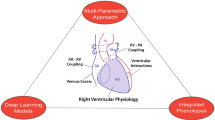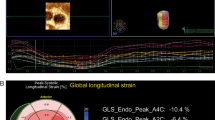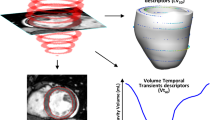Abstract
Cardiac magnetic resonance imaging is currently the technique of choice for precise measurements of ventricular volumes, function and left ventricular (LV) mass. The technique is 3D and hence independent of geometrical assumptions; this, along with its excellent definition of endocardial and epicardial borders, makes it highly accurate and reproducible. Cardiac magnetic resonance (CMR) is particularly useful in research, as it is highly sensitive to small changes in ejection fraction and mass, and only a small number of subjects are required for a study. The excellent reproducibility makes temporal follow-up of any individual patient in the clinical setting a realistic possibility. This review examines the merits of CMR and describes the techniques used.







Similar content being viewed by others
References
Schillaci G, Verdecchia P, Porcellati C, Cuccurullo O, Cosco C, Perticone F (2000) Continuous relation between left ventricular mass and cardiovascular risk in essential hypertension. Hypertension 35:580–586
Lorenz CH, Walker ES, Graham TP Jr, Powers TA (1995) Right ventricular performance and mass by use of cine MRI late after atrial repair of transposition of the great arteries. Circulation 92:II233–II239
St John Sutton M, Otterstat JE, Plappert T, Parker A, Sekarski D, Keane MG, Poole-Wilson P, Lubsen K (1998) Quantitation of left ventricular volumes and ejection fraction in post-infarction patients from biplane and single plane two-dimensional echocardiograms. A prospective longitudinal study of 371 patients. Eur Heart J 19:808–816
Salcedo EE, Gockowski K, Tarazi RC (1979) Left ventricular mass and wall thickness in hypertension. Comparison of M mode and two dimensional echocardiography in two experimental models. Am J Cardiol 44:936–940
Missouris CG, Forbat SM, Singer DR, Markandu ND, Underwood R, MacGregor GA (1996) Echocardiography overestimates left ventricular mass: a comparative study with magnetic resonance imaging in patients with hypertension. J Hypertens 14:1005–1010
Myerson SG, Montgomery HE, World MJ, Pennell DJ (2002) Left ventricular mass: reliability of M-mode and 2-dimensional echocardiographic formulas. Hypertension 40:673–678
Collins HW, Kronenberg MW, Byrd BFd (1989) Reproducibility of left ventricular mass measurements by two-dimensional and M-mode echocardiography. J Am Coll Cardiol 14:672–676
Bellenger NG, Burgess MI, Ray SG, Lahiri A, Coats AJ, Cleland JG, Pennell DJ (2000) Comparison of left ventricular ejection fraction and volumes in heart failure by echocardiography, radionuclide ventriculography and cardiovascular magnetic resonance; are they interchangeable? Eur Heart J 21:1387–1396
Buck T, Hunold P, Wentz KU, Tkalec W, Nesser HJ, Erbel R (1997) Tomographic three-dimensional echocardiographic determination of chamber size and systolic function in patients with left ventricular aneurysm: comparison to magnetic resonance imaging, cineventriculography, and two-dimensional echocardiography. Circulation 96:4286–4297
Gutberlet M, Abdul-Khaliq H, Grothoff M, Schroter J, Schmitt B, Rottgen R, Lange P, Vogel M, Felix R (2003) Evaluation of left ventricular volumes in patients with congenital heart disease and abnormal left ventricular geometry. Comparison of MRI and transthoracic 3-dimensional echocardiography. ROFO Fortschr Geb Rontgenstr Bildgeb Verfahr 175:942–951
Tsujita-Kuroda Y, Zhang G, Sumita Y, Hirooka K, Hanatani A, Nakatani S, Yasumura Y, Miyatake K, Yamagishi M (2000) Validity and reproducibility of echocardiographic measurement of left ventricular ejection fraction by acoustic quantification with tissue harmonic imaging technique. J Am Soc Echocardiogr 13:300–305
Kim WY, Sogaard P, Kristensen BO, Egeblad H (2001) Measurement of left ventricular volumes by 3-dimensional echocardiography with tissue harmonic imaging: a comparison with magnetic resonance imaging. J Am Soc Echocardiogr 14:169–179
Iskandrian AE, Germano G, VanDecker W, Ogilby JD, Wolf N, Mintz R, Berman DS (1998) Validation of left ventricular volume measurements by gated SPECT 99mTc-labeled sestamibi imaging. J Nucl Cardiol 5:574–578
Sharir T, Germano G, Kavanagh PB, Lai S, Cohen I, Lewin HC, Friedman JD, Zellweger MJ, Berman DS (1999) Incremental prognostic value of post-stress left ventricular ejection fraction and volume by gated myocardial perfusion single photon emission computed tomography. Circulation 100:1035–1042
Ostrzega E, Maddahi J, Honma H, Crues JV, 3rd, Resser KJ, Charuzi Y, Berman DS (1989) Quantification of left ventricular myocardial mass in humans by nuclear magnetic resonance imaging. Am Heart J 117:444–452
Sakuma H, Fujita N, Foo TK, Caputo GR, Nelson SJ, Hartiala J, Shimakawa A, Higgins CB (1993) Evaluation of left ventricular volume and mass with breath-hold cine MR imaging. Radiology 188:377–380
Florentine MS, Grosskreutz CL, Chang W, Hartnett JA, Dunn VD, Ehrhardt JC, Fleagle SR, Collins SM, Marcus ML, Skorton DJ (1986) Measurement of left ventricular mass in vivo using gated nuclear magnetic resonance imaging. J Am Coll Cardiol 8:107–112
Keller AM, Peshock RM, Malloy CR, Buja LM, Nunnally R, Parkey RW, Willerson JT (1986) In vivo measurement of myocardial mass using nuclear magnetic resonance imaging. J Am Coll Cardiol 8:113–117
Germain P, Roul G, Kastler B, Mossard JM, Bareiss P, Sacrez A (1992) Inter-study variability in left ventricular mass measurement. Comparison between M-mode echography and MRI. Eur Heart J 13:1011–1019
Myerson G, Montgomery HE, Whittingham M, Jubb M, World M, Humphries S, Pennell DJ (2001) Left ventricular hypertroph with exercise and ACE gene insertion/deletion polymorphism, a randomised controlled trial with losartan. Circulation 103:226–230
Myerson SG, Bellenger NG, Pennell DJ (2002) Assessment of left ventricular mass by cardiovascular magnetic resonance. Hypertension 39:750–755
Grothues F, Smith GC, Moon JC, Bellenger NG, Collins P, Klein HU, Pennell DJ (2002) Comparison of interstudy reproducibility of cardiovascular magnetic resonance with two-dimensional echocardiography in normal subjects and in patients with heart failure or left ventricular hypertrophy. Am J Cardiol 90:29–34
Mogelvang J, Stubgaard M, Thomsen C, Henriksen O (1988) Evaluation of right ventricular volumes measured by magnetic resonance imaging. Eur Heart J 9:529–533
Mackey ES, Sandler MP, Campbell RM, Graham TP Jr, Atkinson JB, Price R, Moreau GA (1990) Right ventricular myocardial mass quantification with magnetic resonance imaging. Am J Cardiol 65:529–532
Pattynama PM, Lamb HJ, Van der Velde EA, Van der Geest RJ, Van der Wall EE, De Roos A (1995) Reproducibility of MRI-derived measurements of right ventricular volumes and myocardial mass. Magn Reson Imaging 13:53–63
Helbing WA, Rebergen SA, Maliepaard C, Hansen B, Ottenkamp J, Reiber JH, de Roos A (1995) Quantification of right ventricular function with magnetic resonance imaging in children with normal hearts and with congenital heart disease. Am Heart J 130:828–837
Helbing WA, Bosch HG, Maliepaard C, Rebergen SA, van der Geest RJ, Hansen B, Ottenkamp J, Reiber JH, de Roos A (1995) Comparison of echocardiographic methods with magnetic resonance imaging for assessment of right ventricular function in children. Am J Cardiol 76:589–594
Hazekamp MG, Kurvers MM, Schoof PH, Vliegen HW, Mulder BM, Roest AA, Ottenkamp J, Dion RA (2001) Pulmonary valve insertion late after repair of Fallot’s tetralogy. Eur J Cardiothorac Surg 19:667–670
Discigil B, Dearani JA, Puga FJ, Schaff HV, Hagler DJ, Warnes CA, Danielson GK (2001) Late pulmonary valve replacement after repair of tetralogy of Fallot. J Thorac Cardiovasc Surg 121:344–351
Fieno DS, Jaffe WC, Simonetti OP, Judd RM, Finn JP. TrueFISP (2002) Assessment of accuracy for measurement of left ventricular mass in an animal model. J Cardiovasc Magn Reson Imaging 15:526–531
Plein S, Bloomer TN, Ridgway JP, Jones TR, Bainbridge GJ, Sivananthan MU (2001) Steady-state free precession magnetic resonance imaging of the heart: comparison with segmented k-space gradient-echo imaging. J Magn Reson Imaging 14:230–236
Alfakih K, Thiele H, Plein S, Bainbridge GJ, Ridgway JP, Sivananthan MU (2002) Comparison of right ventricular volume measurement between segmented k-space gradient-echo and steady-state free precession magnetic resonance imaging. J Magn Reson Imaging 16:253–258
Bloomer TN, Plein S, Radjenovic A, Higgins DM, Jones TR, Ridgway JP, Sivananthan MU (2001) Cine MRI using steady state free precession in the radial long axis orientation is a fast accurate method for obtaining volumetric data of the left ventricle. J Magn Reson Imaging 14:685–692
Alfakih K, Plein S, Bloomer T, Jones T, Ridgway J, Sivananthan M (2003) Comparison of right ventricular volume measurements between axial and short axis orientation using steady-state free precession magnetic resonance imaging. J Magn Reson Imaging 18:25–32
Lorenz CH, Walker ES, Morgan VL, Klein SS, Graham TP Jr (1999) Normal human right and left ventricular mass, systolic function, and gender differences by cine magnetic resonance imaging. J Cardiovasc Magn Reson 1:7–21
Alfakih K, Plein S, Thiele H, Jones T, Ridgway JP, Sivananthan MU (2003) Normal human left and right ventricular dimensions for MRI as assessed by turbo gradient echo and steady-state free precession imaging sequences. J Magn Reson Imaging 17:323–329
Author information
Authors and Affiliations
Corresponding author
Rights and permissions
About this article
Cite this article
Alfakih, K., Reid, S., Jones, T. et al. Assessment of ventricular function and mass by cardiac magnetic resonance imaging. Eur Radiol 14, 1813–1822 (2004). https://doi.org/10.1007/s00330-004-2387-0
Received:
Accepted:
Published:
Issue Date:
DOI: https://doi.org/10.1007/s00330-004-2387-0




